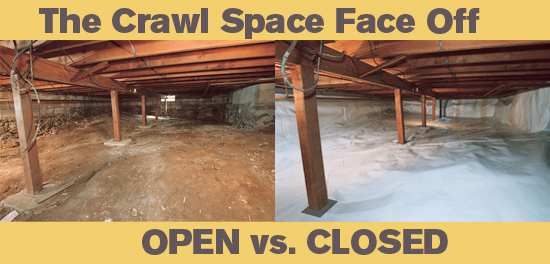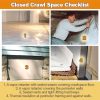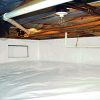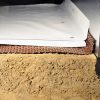A new way to solve an old problem
More than 27 million homes in the U.S. have crawlspaces. That number grows every year, as 15 to 20 percent of new homes continue to be built over crawlspaces.
That’s a lot of houses, most of which are probably suffering from a variety of problems.
They include excessive moisture and what comes with it: mold and mildew, wood rot, corrosion, poor indoor air quality, and insect and pest infestation. They also include excessive energy loss (especially where there are ducts in the crawlspace), cold floors, high fuel bills, and greater wear and tear on HVAC equipment.
Most of these problems are due to one-size-fits-all building codes, cost-cutting construction practices, inadequate waterproofing, insufficient air sealing, and using the wrong type of insulation. Fortunately, building scientists have revised their thinking about crawlspace design and have devised ways to eliminate or at least minimize the ills associated with crawlspaces. Codes are changing as well.
Caption: The South Atlantic, East South Central, and Pacific states have the largest concentrations of homes with crawlspaces, according to the Census Bureau’s Survey of Construction.
The closed-versus-vented question
 Closed or “encapsulated” crawlspaces are now preferred to open, or vented, crawlspaces.
Closed or “encapsulated” crawlspaces are now preferred to open, or vented, crawlspaces.
Closed crawlspaces are consistently better at controlling moisture that enters via the damp earth or from warm humid air that would otherwise infiltrate from the outdoors.
Tests done for the Environmental Protection Agency (EPA) by Advanced Energy have shown that closed crawlspaces maintain significantly lower levels of relative humidity (RH). In a multi-home test done in Baton Rouge, Louisiana, for example, the average relative humidity of closed crawlspaces barely exceeded 60 percent.
Meanwhile, vented crawlspaces in control homes had readings in excess of 80 percent. In a similar test in Flagstaff, Arizona – a colder, dryer climate – vented crawlspaces stayed below 70 percent RH, but sealed crawlspaces were less. They never exceeded 50 percent RH.
The winner: closed, encapsulated crawlspaces have lower relative humidity, which means less rot, better air quality and fewer pests.
Click here for more information on crawlspace encapsulation.







I have a very sick home with four innocent children. I have had numerous so called experts take advantage of my situation for no changes afterwards. I live in Baton Rouge and would love to get your expert advice on my home and if it’s possible make my home healthy. We have high particulate matter in the air and my 7 year old has a very rare lung disease making it worse, I need someone highly experienced as my home is baffling! Please contact me ASAP if you can I would love your insight! We lost our last home to Chinese Drywall or we would leave this home but concerned with ruining our credit!
Very Distraught,
Crystal
Myhomescience.com is working with Crystal offline to determine the cause of her problem. For curious readers, it has been determined that dust from fiberglass insulation, combined with a poorly air-sealed home, may be the culprits.
Greetings From Chicago!
I have a question. I have a dirt crawl space that has a vapor barrier on the ground and up the foundation walls under my living room. Can I install rigid foam insulation board over the barrier to insulate the walls or do I need to remove the barrier and install the foam board directly on the concrete wall, then put the barrier back over it? I do have insulation in the floor joists that when a finish with the walls I was going to remove and place on the crawl floor to insulate it.
Thanks for any help.
Gus
The foam board can be installed over the vapor barrier, but it will take a great deal of time and trouble because you’ll have to drill through the foam and the plastic barrier, and into the concrete, then secure the foam board with masonry anchors. An easier strategy would be to pull the barrier off the walls, and use a foam panel adhesive to adhere the foam directly to the concrete. Seal the joints between foam panels with spray foam or sealant, then reinstall the vapor barrier. It’s also recommended to seal & insulate the rim joist and mudsill that rest atop the foundation. This can be done by friction-fitting rigid foam board against the rim joist and between floor joists, then sealing around the insert with spray foam.
Good articlе. I ԁefinitely appreciate this website.
Continue the good work!
I recently purchased a house that was built in 1975 that has a partial basement and one room (sunken living room) is over a crawlspace. Currently the living room has carpet and we would like to install wood flooring. The crawlspace has two vents and a dirt floor which shows no signs of water. The dirt is dry and there does not appear to be a water issue in the crawlspace. The house is in Connecticut and the soil surrounding my home is wet and mossy. I was thinking about a concrete floor and installing a small door to the outside so it could by used for storage. Is this advisable? Which type of crawlspace treatment would be best? P.S. it gets very cold in the winter and very hot/humid in the summer here.
Encapsulation, including wall insulation, is a better than pouring a slab. The vents will be sealed and the crawlspace will become semi-conditioned space. Your floors will be warmer and the house will have a lower relative humidity in summer. Consider installing TerraBlock over the dirt floor. In addition to sealing out moisture, it provides a thermal break. It’s touch enough to stand up to some traffic should you want to use the space for storage.
We have a home built in 1996, that has a crawlspace under the basement subfloor, as well as an Active Subslab suction (sump-hole suction variation). We are looking to put some plumbing into the crawlspace area and need to make it an encapsulated and ‘conditioned’ crawlspace by a supply HVAC system duct (along with the polyethylene membrane and foam insulation up the sides).
My question is, with the radon suction, do we need to install a transfer grilles to the common basement area (return air pathway). I know we need to if there is no radon mitigation, but there is no information on local codes and IRC codes how to do this with a subslab suction radon mitigation system that would be operating under the plastic membrane. The EPA said they had no guidance in my case. Without a transfer grille, it seems there would be a negative pressure created by the HVAC supply in the crawlspace. However, with transfer grilles back into the house, I don’t want it to negate the Radon suction system either. I am thinking that the Radon suction is underground and under the plastic membrane and should not be affected if the crawlspace is correctly sealed. However, we could also install a small vent to the outside to relieve the negative pressure in the crawlspace (making it not fully encapsulated and loosing a bit of heat).
Any advice on whether or not to install transfer grilles? Thanks in advance!
I suggest contacting a licensed radon mitigation contractor in your area. You can locate a National Radon Defense contractor through the network at http://www.nationalradondefense.com/.
The radon mitigation expert and an HVAC guy both said NO transfer grille to the main basement living area. The small amount of air supply down there will slowly dissipate to the outside through cracks/gaps.
We had a new A/C unit put in this summer. During this installation we realized that we had a moister problem underneath our home. The vapor barrier that is there is in bad shape and we know we need to replace it. Some of the duct work is in bad shape and wet to the touch. There is water pooled in small spots on top of the vapor barrier. Our insalation on the subfloor, below our wood floors, are sagging and obviously experiecing moisture. We live in South Carolina and today I had a company come out and look at the crawl space. They advised that there is a small amount of mold beginning to grow but that it was not bad. They agreed that we had a moisture issue. They suggested pulling all insulation and old vapor barrier. They stated that the would replace vapor barrier and install a dehumidifier in the crawl space as well as seal vents. My concern is that the dehumidifier would not keep up with humidity in the crawl space without it being encapsulated. I would think that a dehumidifier would be able to suck wet air from the walls and ground since the space is not sealed. What are your thoughts? This does not sound like it would fix my issues.
We recently purchased a home in the Northeast with a concrete block dirt floor crawl space. There is definitely signs of moisture and an old unoperable sump pump. We want to take care of the crawlspace before doing any renovations. Currently it is vented with an fan during the summer months. Should we consider closing it in? Want to get it right.
Just built a 30 x 30 with a 4 foot crawl space in illinois. Got 10mil vapor barrier down and 2 inch insulation on the walls. Everyone is telling me to vent the crawl space, everyone is telling me this why? Is there a advantage in illinois of venting?
My home was built in 1864 in sw Missouri and has a creek pebble foundation with vents on a crawlspace, it has no sub floor just t&g planks which have mysterious moisture spots appearing so we are removing floor and plan on rigid foam panels to interior foundation walls,10mil plastic sheeting w/6″-8″ overlap taped as we add new treated joists and subflooring with this said my question is are we able to seal closed the vents completely?
Do you have to install insulation in the floor joists with a closed crawl space?
That wa a great barticle. Thank you for the information.
I have a crawlspace that cannot be encapsulated. We were thinking about closing up the close space with two exhaust fans. Do you have to worry about negative pressure if the crawl space is not encapsulated?
Was there ever a response to this? I have an vented crawl space that cannot be encapsulated as well.
That depends on the size of the exhaust fans and how air sealed the house and crawlspace are, but it’s usually ok, but be aware that it may let the makeup air be from either the house or outside. Some people prefer this system as it helps with radon mitigation, but it is not reliable for moisture control. Crawlspace Ninja would have you combine the exhaust fan with a dehumidifier.
What’s up, this weekend is pleasant for me, since this time i
am reading this fantastic educational piece of writing here at my residence.
I love reading through and I conceive this website got
some really utilitarian stuff on it!
Great post.Ne’er knew this, thank you for letting me know.
I was studying some of your blog posts on this site and I conceive this website is really
informative! Keep putting up.
Pretty! This has been an extremely wonderful article.
Thank you for supplying these details.
No matter if some one searches for his necessary thing,
so he/she wants to be available that in detail, thus that thing is maintained over here.
Basically to follow up on the update of this topic on your website and wish to let you
know just how much I liked the time you took to put together this valuable post.
Within the post, you really spoke regarding how to definitely handle this problem with all comfort.
It would be my personal pleasure to build up some more thoughts from your web site
and come as much as offer other people what I discovered from you.
Thank you for your usual terrific effort.
Sweet website, super design and style, rattling clean and utilise pleasant.
Thanks for sharing your thoughts about skin care p.
Regards
I like this web blog very much so much wonderful information.
I rarely leave comments, however after reading through a ton of responses on this page The Crawlspace Argument:
Open (Vented) vs Closed (Encapsulated) – MyHomeScience.
I do have a couple of questions for you if you do not mind.
Is it simply me or does it look like a few of the responses appear like they are coming from brain dead people?
😛 And, if you are posting on other online sites, I’d
like to keep up with everything new you have
to post. Would you make a list of all of all your social community
pages like your Facebook page, twitter feed, or linkedin profile?
always i used to read smaller content which also clear their motive, and that is
also happening with this article which I am reading at this place.
Thank you for helping out, fantastic information.
It’s amazing designed for me to have a web page, which is valuable
for my experience. thanks admin
I like this web site very much, Its a real nice berth to read and receive info.
Glad to be one of the visitants on this amazing web site :D.
Good ? I should certainly pronounce, impressed with your website.
I had no trouble navigating through all tabs as well as related info ended up being truly
easy to do to access. I recently found what I hoped for before you know it in the least.
Reasonably unusual. Is likely to appreciate it for those who add
forums or something, site theme . a tones way for your client
to communicate. Nice task.
Just wanna comment on few general things, The website pattern is perfect, the subject matter is really great
:D.
This is very attention-grabbing, You’re an overly professional blogger.
I have joined your rss feed and look ahead to in quest of extra of your
magnificent post. Also, I’ve shared your website in my
social networks!
Hi mates, how is the whole thing, and what you want to
say on the topic of this paragraph, in my view its truly awesome in favor
of me.
Some genuinely nice and useful information on this site, besides I conceive
the design and style contains good features.
An intriguing discussion is worth comment. I think that you need to publish more about this subject, it may not be a taboo matter but usually people don’t talk about such subjects.
To the next! All the best!!
If you desire to take a good deal from this piece of writing then you
have to apply such methods to your won weblog.